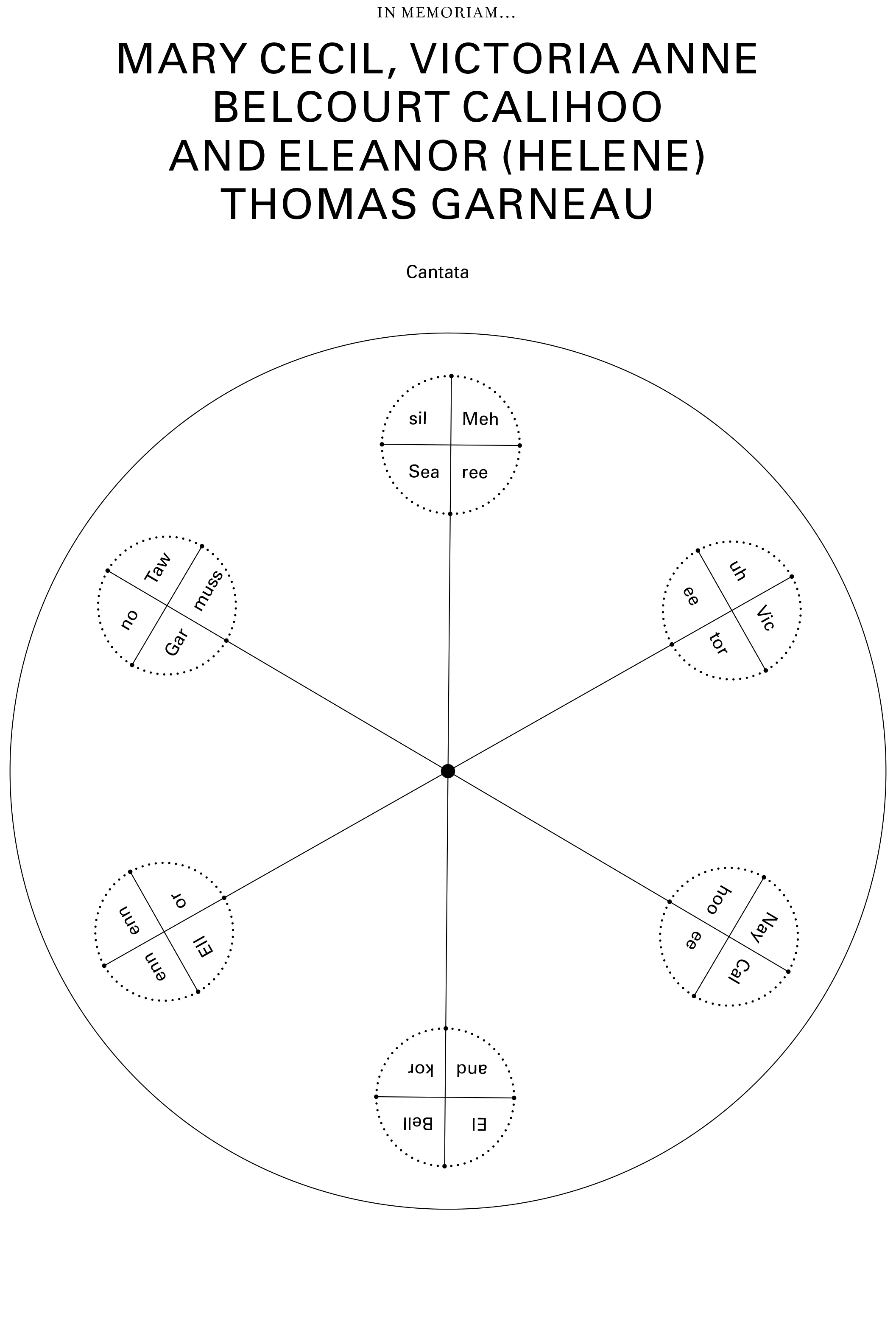in memoriam…

in memoriam… Mary Cecil, Victoria Callihoo (née Belcourt), and Eleanor (Helene) Thomas Garneau
By Alex Waterman and Postcommodity
The first performance of in memoriam… and a subsequent publication were curated by Ociciwan Contemporary Art Collective. The version of the score that appears here and in V38: Feminisms of The Site Magazine was curated by Ociciwan in collaboration with our editorial team.
Instructions
For three vocal groups (of four or more singers) and four or more auxiliary performers
The piece begins with a single SONORITY established by the four auxiliary performers dipping pieces of cloth of various sizes in buckets of water and/or dye and hanging them over metal basins, producing an ever-shifting changing soundscape and mixing of colors. This forms the common SONORITY. As the piece develops, the voices may find a place inside of this and increase the complexity of the collectively produced sonority.
After the sonority is established (this should take some time) the singers enter with their first syllables. Once they begin, they repeat their syllables slowly (the length of one breath) sixteen times before rejoining the sonority (large black dots) by moving to the inner circle and creating a collective sonority based on a shared word.
Each of the smaller circles with syllables in each of the four quadrants, is composed of sixteen small dots between the four larger dots at the cardinal points. The smaller dots represent sixteen utterances of the syllables that are written in that quadrant. Each utterance is the full length of an exhalation. The large dots represent a shared vocal sonority.
This will be a singular pitch or noise agreed upon by each individual group or by all three groups. This vocal sonority is to be distinguished from the overall drone produced by auxiliary instruments of the ensemble ’s choosing. The choice of instruments may be informed by the reading of the biographical materials on these three women’s lives.
If the performers wish to make a longer piece, their next move would be to move to the circle next to where they started (moving counter-clockwise). The following move would be to go to the circle opposite it, and so on. This can continue until each group has sung each of the circles and moved to the centre six times.
When all the cycles of syllables are complete (see above for how to determine the overall length of the piece), the singers will begin to sing the full names of the women who they have been embodying in sound, repeating them over and over. These names are repeated until the auxiliary performers raise their arms to fade out the voices. This is followed by the auxiliary sounds fading out…the last sounds will be those of the water dripping.
Alternative Instructions For Audience Participation
At the SONORITY (large dots), the singers move out into the audience and “pass” each syllable to individual audience members who are encouraged to keep repeating those syllables for the remainder of the piece and/or until they are asked to sing a new syllable. The lead singers can inflect or change the intonation/accent of any of the syllables during the singing of it. In other words, the syllables could be sung in different timbres by multiple voices at any given moment (simultaneously).
The piece ends when all the audience members are back in the hall repeating the full names for as long as the collective feels is necessary. The “lead” singers direct the fade out of the names followed by the auxiliary sounds fading out.
Mary Cecil
Cree. Birth and death dates unknown.
Mary Cecil was a Cree midwife that lived and worked in Stoney Nakoda during the late 1800’s and the early 1900’s. There is not a lot of information about how she came to live on Stoney. We do know she was the midwife, servant and nurse to the McDougall family, who were Methodist missionaries on the Stoney Nakoda reserve.
Mary Cecil attended Eliza Boyd, the wife of John McDougall a well-known Methodist missionary, and her sister-in-law Annie McDougall when they gave birth to each of their children at the Stoney reserve in the late nineteenth century. Cecil worked for the McDougalls as not only their midwife, but as their nurse and servant for many years.(1)
…she had soon become very fond of (her) because of her kindness and faithfulness. For twenty-eight years I had no better servant or friend, and the children loved her as well as any white woman.
– Annie McDougall, interviewed by journalist Elizabeth Bailey Price, 1920s. (2)
Even with the lack of information, Indigenous midwives, are referenced widely in letters and journals of the early pioneers. With doctors scarce, the pioneer women were forced to rely on Indigenous medicine women and midwives to help them birth their children as well as nurse their children when they were sick. The midwives would use their traditional medicines and knowledge within these processes. (3)
Victoria Callihoo (née Belcourt)
Métis (Cree and French).
Born and lived in Lac Ste. Anne, AB. 1861–1966.
Victoria Callihoo (née Belcourt) was born in Lac Ste. Anne in November 1862, to a Cree medicine woman and was baptized by Father Albert Lacombe, OMI. She attended school for a short time, at the age of thirteen, she took part in her first buffalo hunt in a traditional Red River cart. In 1879 Victoria married Louis Callihoo and together they had twelve children – six boys and six girls; speaking both French and Cree within their household. While the Callihoo’s were raising their family, they hauled freight for the Hudson’s Bay Company between Edmonton and Athabasca Landing.
Many of the Métis in this region made their living by transporting supplies. Women took part in all types of work to help bring in money and Victoria was able to use her skill as a horsewoman to help her family. Louis and Victoria also farmed, had a sawmill, and ran a hotel for a time.
Victoria Callihoo was always an avid dancer, at the age of 100 she danced a Red River Jig at her birthday celebration. Victoria was 104 when she died at the Youville Home in St. Albert.” (4)
Eleanor (Helene) Thomas Garneau
Métis.
Born in Swampy Village, Red River, MB, lived in Edmonton and St. Paul des Métis (now St. Paul, AB). 1852–1912.
Eleanor was a Gaelic, Cree speaking Métis married to Lawrence (Laurent) Garneau. She was the grandmother of Métis patriot Jim Brady and great-great grandmother of artist David Garneau. Jim Brady tells of his grandmother’s action in the 1885 resistance:
Riel and his council had sent letters to my grandfather and Vandal inquiring as to the local situation and the degree of support that could be expected from the local Métis. My grandfather (Lawrence) kept this letter to read to some of the Metis sympathizers who were illiterate. My grandmother (Eleanor) was in the kitchen when a sergeant and four constables of the NWMP galloped in the yard (they had a warrant for Garneau’s arrest and a search warrant for the premises). The sergeant bounded up the stairs to place my grandfather’s arrest. The other police immediately ransacked the house. One policemen went to the actual spot where the letter had been hidden. My grandmother acted with great presence of mind. She had been laundering when they came into the yard, and she reached up, place the letter and other incriminating material in the washtub, and calmly destroyed them by rubbing them on the washboard until they were completely disintegrated. (5)
Commentary
This piece shares several formal features with American composer Robert Ashley’s in memoriam…Esteban Gómez. The first and most superficial is that it borrows the graphic features of the circle from Ashley’s score and with this borrowing several of its original meanings are left intact. For one, the notion of [a] subjective, individually felt temporality vs. a shared objective sense of time (i.e. clock time) is central to both pieces. In addition, this piece shares with …Esteban Gómez the formal concept of a collective sonority or “drone” as its starting point and its goal point as opposed to a traditional notion of harmonic centre (key) or goal (cadence). No matter the course of musical actions within the relatively short durations of each quadrant of the circle, the singers and performers always return to the sonority/drone.
in memoriam...Mary Cecil... also shares a visual connection with the “wheel” of the in memoriam…Crazy Horse score. In that score, the wheel was a metaphor for westward expansion in the Americas. In this work, the wheel serves to move inwards to remind us of internal forms of measurement, sensorial feedback, and memory. This new score suggests a ritual means to break down the name into its sonic components in order to hear the internal music of these names. This is a loving act of holding each sound of the name in one’s body, resonating it together before collectively singing the whole names at the end of the ritual in order that we all remember these women.
The dripping, waterlogged soundscape of cloth dying and washing, and its associations with domestic labor—provide the central drone, while the performers intone the fragments of three Indigenous women’s names.
Staging Specific to the Canadian Premiere
in memoriam…Mary Cecil, Victoria Anne Belcourt Callihoo and Eleanor (Helene) Thomas Garneau was first performed July 18, 2017, at the Francis Winspear Centre for Music in Edmonton, Alberta, by the transdisciplinary Indigenous artist collective Postcommodity, composer Alex Waterman, and Indigenous musicians from across the province of Alberta. This fifth in memoriam… is a collectively composed addition to Ashley’s four graphic scores, which tell the stories of (in)famous figures from American history: Esteban Gómez and Crazy Horse, as well as Kit Carson and John Smith. This new in memoriam… sings the stories of these extraordinary women presents them to a wider audience. For the July 2017 performance, all five in memoriams featured new handmade musical instruments, performed by regional Indigenous musicians and these extraordinary international artists.
Instruments and Materials
Washboards
Water
Paper
Voices
Cloth
Performers for the Canadian Premiere
Malaya Bishop
seth cardinal
Ociciwan Contemporary Art Collective
Curtis Lefthand
Jaynine Lena McCrae
nêhiyawak (Kris Harper, Matthew Cardinal, and Marek Tyler)
Amber Paquette
Postcommodity
Jared Tailfeathers
Alex Waterman
Endnotes
(1) Burnett, Kristin, “Obscured Obstetrics: Indigenous Midwives in Western Canada,” in Recollecting: Lives of Aboriginal Women of the Canadian Northwest and Borderlands, eds. Sarah Carter and Patricia McCormack (Edmonton: Athabasca University Press, 2011), 157–171.
(2) Burnett, Kristin, “The Healing Work of Aboriginal Women in Indigenous and Newcomer Communities,” in Place and Practice in Canadian Nursing History, eds. Jayne Elliott, Meryn Stuart, Cynthia Tolman (Vancouver: UBC Press, 2009), 40–52.
(3) Burnett, Kristin, “Obscured Obstetrics: Indigenous Midwives in Western Canada,” in Recollecting: Lives of Aboriginal Women of the Canadian Northwest and Borderlands, eds. Sarah Carter and Patricia McCormack (Edmonton: Athabasca University Press, 2011), 157–171.
(4) “Happy National Aboriginal Day,” musée héritage, June 21, 2012, accessed May 16, 2017, http://museeheritage.ca/ happy-national-aboriginal-day.
(5) Women of the Métis Nation, eds. Lawrence J. Barkwell and Leah Dorion (Winnipeg: Louis Riel Institute 2004), 109.














